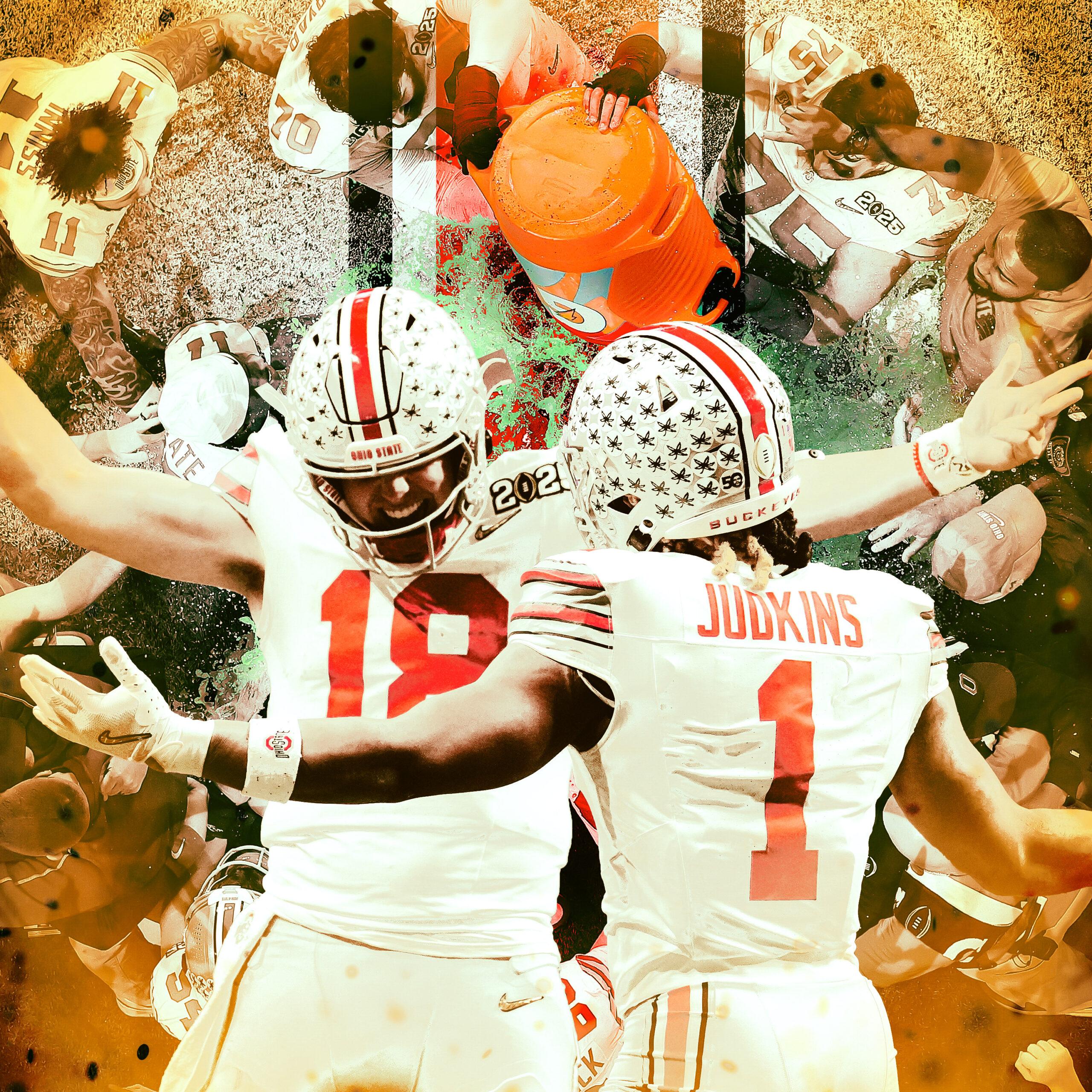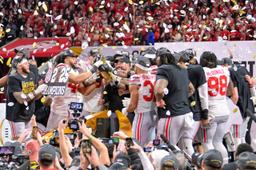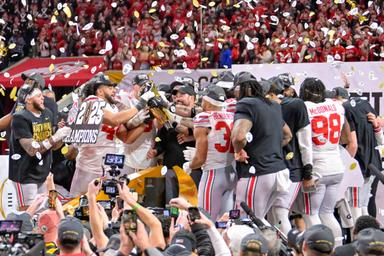
Ohio State Is College Football’s First NIL National Champion
Will Howard. Quinshon Judkins. Caleb Downs. The Buckeyes took advantage of college football’s new landscape better than anyone. By winning the title, they also may have set the blueprint for champions to come.Much has been made of the fact that Ohio State’s NIL collectives spent as much as $20 million to build this season’s Buckeyes roster, plucking a Big 12–champion quarterback here, the last two SEC freshmen of the year there, and a promising freshman quarterback and a three-year starting center from Alabama for good measure. The Buckeyes’ offseason spending spree was an astonishing outlay of money for a college football team. And it worked out—to the point that it could ramp up the sport’s arms race in ways few could have previously anticipated.
Ohio State mostly cruised to its first national championship in 10 years on Monday night, holding off plucky but limited Notre Dame in a 34-23 win in the first title game of the inaugural 12-team College Football Playoff. Running back Quinshon Judkins, formerly of Ole Miss, scored three touchdowns; quarterback Will Howard, formerly of Kansas State, threw for two more; and wide receiver Jeremiah Smith, formerly of Chaminade-Madonna College Preparatory School in Hollywood, Florida, had 88 yards and a touchdown as Ohio State’s offseason transfer pickups joined forces with its usual bevy of five-star recruits and future NFL draft picks to win its biggest game in a decade.
“People talked a lot about how much money guys were making in NIL and different things like that—that was just because NIL was available,” Buckeyes head coach Ryan Day said after the game. “That doesn’t mean a whole lot other than the fact that the market value for our guys in Columbus at Ohio State is pretty high. When that got tagged on us early, there was a lot of pressure put on our players.”
As scarlet-and-gray confetti rained down on the field in the postgame celebration, the Buckeyes and their supporters repeatedly tried to steer the conversation toward how their culture and camaraderie were more responsible for Monday’s triumph than the millions spent stockpiling premier players.
“You can have all the money, all the collectives you can have, but if you don’t have a foundation of leadership and culture and chemistry, then it’s not going to matter,” Ohio State athletic director Ross Bjork said. “You guys keep talking about that—the $20 million roster has nothing to do with the character of this program,” said Gene Smith, the school’s former athletic director. “They spent a lot of money in the portal or whatever … you still have to coach these guys, they still gotta jell and become a unit,” said Orlando Pace, the Hall of Fame offensive lineman who played at Ohio State from 1994 to 1996.
Still, it’s undeniable that the Buckeyes started shaping up as title contenders in January, when they landed Howard and Judkins out of the transfer portal in the same week. And whereas past college football champions have made use of NIL funds to retain the talent already on their roster, this group surpassed that.
The Buckeyes loaded up for this year as a kind of response to Michigan, which leaned heavily on its NIL collective to bring back several of its stars for its 2023 championship run. Meanwhile, Ohio State used its money both to keep its top-end talent—like receiver Emeka Egbuka, defensive end Jack Sawyer, and tackle Donovan Jackson—and strategically poach some. The program simply leveraged college football’s new landscape better than anyone else.
Judkins announced his commitment on January 7, 2024, hardly minutes after Ohio State’s archrival Michigan claimed its first national championship in 26 years. “I chose this place because I wanted to win to be part of a championship program,” said Judkins, a two-time first-team All-SEC selection who rushed for 2,725 yards and 31 touchdowns in two seasons at Ole Miss. In choosing Ohio State, Judkins had to accept a costarring role alongside fellow back TreVeyon Henderson. But he also had a sense of what the Buckeyes were building.
Over the summer, Day’s predecessor, Urban Meyer, mused that Ohio State had “one of the most talented rosters in the last decade, maybe ever.” An NFL scout told ESPN that “pound for pound, player for player, they have as many good players as any [college] team that I can remember.” The Buckeyes entered the season ranked no. 2 in most preseason polls, taking what appeared to be a perfunctory spot behind two-time defending champ Georgia. It figured that Ohio State would be able to prove its worthiness in relatively short order.
But then a funny thing happened: The team mostly underperformed. The Buckeyes took a one-point loss at Oregon in October, put forth a surprisingly uninspired effort in a narrow win against Nebraska, and, of course, suffered a stunning humiliation against Michigan in the regular-season finale. To reframe what Pace said: They didn’t jell and become a unit for most of last fall.
In any other season, the Michigan loss could have been the closing argument for Day: The program could have fired him and its best players could’ve rushed off to the NFL or the transfer portal. But the expanded playoff format gave the Buckeyes another chance to live up to their lofty preseason billing. In response, they hammered the committee’s ninth- (Tennessee), first- (Oregon), and fifth-ranked teams (Texas) to make amends for their earlier letdowns and advance to the national championship game. In the semifinal win against the Longhorns, safety Caleb Downs—a prized transfer from Alabama who might be the best defensive back in the sport—sealed the victory with an emphatic interception.
And in a title game almost 600 miles away from Columbus, the Buckeyes fans filled about two-thirds of the seats at Mercedes-Benz Stadium and turned a game at an ostensibly neutral site into a decided home-field advantage.
Notre Dame opened the game with a methodical, nearly 10-minute touchdown drive that included two fourth-and-1 conversions. But the Irish looked afterward as if they’d landed their best shot, and quarterback Riley Leonard rushed to the sideline to vomit and then stumbled over to the bench area.
The Buckeyes quickly seized back control of the game on their first offensive drive, featuring a 19-yard run by Henderson, a 15-yard run by Judkins, and a 12-yard completion to Egbuka. Then Smith, the freshman phenom, motioned like he was going for a jet sweep and quickly reversed course to find himself all alone in the flat for an 8-yard touchdown that tied the game.
And while Notre Dame went three-and-out on its next two possessions, Ohio State scored touchdowns on its next three drives and added a field goal on the fourth to extend its lead to 31-7. “We really had an answer for everything they could have given us,” said Howard, who completed his first 13 passes for 138 yards and a touchdown. He finished 17-of-21 for 231 yards and added 51 rushing yards, including seven first downs.
While basking in the glow of reaching college football’s mountaintop, Howard looked back on his journey to Ohio State. After starting for two years at Kansas State, he decided to enter the portal, and briefly considered heading to USC before landing in Columbus. And following his arrival, the transfer excelled, winning a national championship and significantly improving his draft stock.
“That was really what the ultimate motivation was for me,” Howard said. “Obviously, the NIL money, it was nice to get. But if I would have been in it for the money, I probably would have been somewhere else, to be honest with you.”
Of course, there’s no need to deny the obvious: Bidding wars—at least public bidding wars—are now part of the college football championship blueprint. The sport has changed in countless ways in recent years, and the team hoisting the trophy Monday reflected that. It adjusted its script, and it dotted the i.
Last season, Michigan got what it paid for. This season, so did Ohio State.



